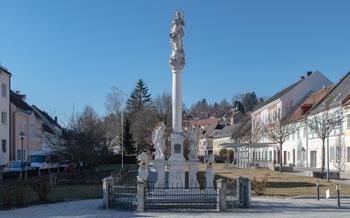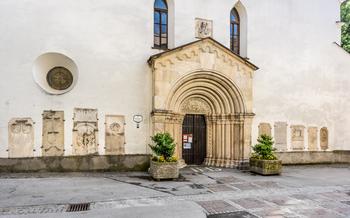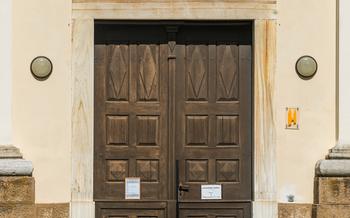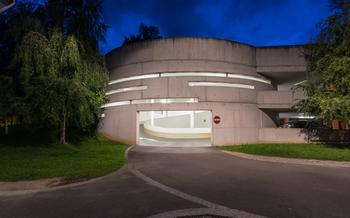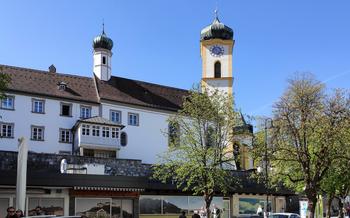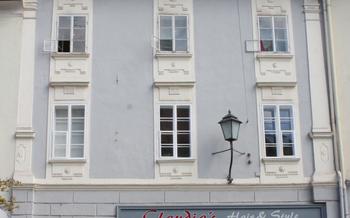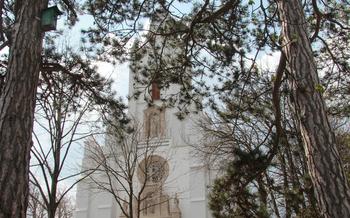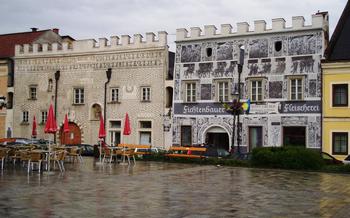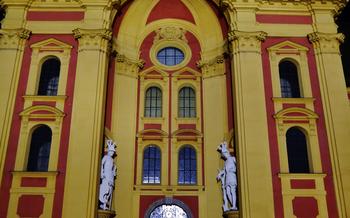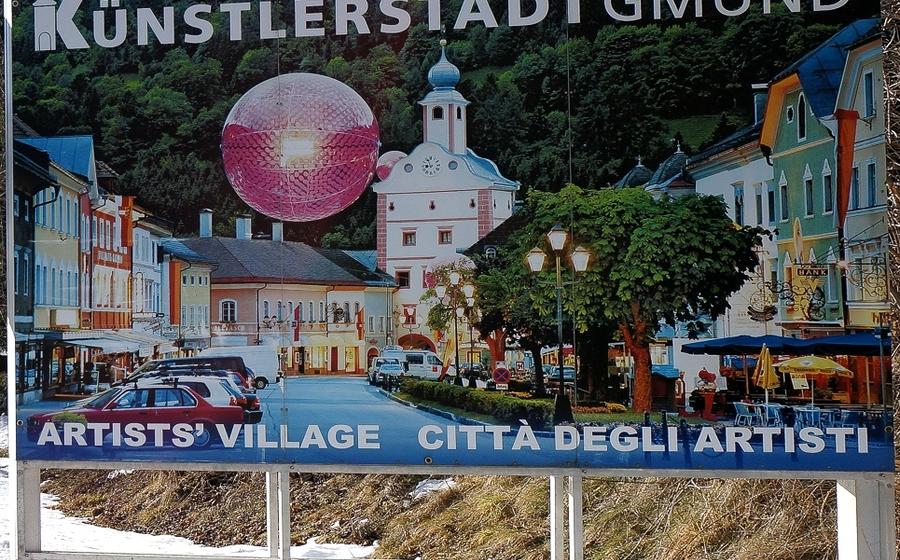
Benedictine Monastery of St. Paul
- History of the Benedictine Monastery of St. Paul
- Architecture and Art at St. Paul
- The Monastery Church
- The Monastery Library
- The Monastery Museum
- The Monastery Gardens
- The Monastery Shop and Bookstore
- Guided Tours of the Monastery
- Events and Concerts at the Monastery
- The Monastery's Spiritual Retreats
- The Monastery's Hospitality
- The Monastery's Surroundings
- The Monastery's Role in the Community
- The Monastery's Future
- Insider Tip
History of the Benedictine Monastery of St. Paul
Founded in 1091 by Count Siegfried of Sponheim, the Benedictine Monastery of St. Paul is one of the oldest and most important monasteries in Austria. Located in the charming town of Gmünd, the monastery has played a significant role in the region's history, culture, and spirituality for over 900 years.
In its early years, the monastery was a center of learning and scholarship. The monks copied and illuminated manuscripts, and the monastery's library became one of the most important in the region. The monastery also played a role in the development of the local economy, as the monks cleared land for agriculture and established trade routes.
During the Middle Ages, St. Paul's grew in wealth and influence. The monastery acquired extensive lands and properties, and its abbots were often powerful figures in the region. The monastery also became a center of pilgrimage, as people from all over Europe came to visit the relics of St. Paul, the apostle.
The Reformation and the Counter-Reformation had a significant impact on St. Paul's. During the Reformation, many of the monastery's lands were confiscated by Protestant rulers. The monastery was also attacked and looted by Protestant mobs. However, the monastery survived these challenges and remained a center of Catholic worship and culture.
In the 17th and 18th centuries, the monastery underwent a period of Baroque renovation. The monastery church was rebuilt in the Baroque style, and the monastery's library was expanded and decorated with frescoes and ceiling paintings. The monastery also acquired a number of new works of art, including paintings, sculptures, and tapestries.
Today, the Benedictine Monastery of St. Paul is a thriving community of monks. The monastery continues to be a center of worship, learning, and hospitality. The monastery is also a popular tourist destination, and visitors from all over the world come to admire its architecture, art, and history.
Architecture and Art at St. Paul
The Benedictine Monastery of St. Paul is a stunning example of Romanesque and Gothic architecture. The monastery church, built in the 12th century, is one of the largest and most impressive Romanesque churches in Austria. The church's exterior is characterized by its massive stone walls, round-arched windows, and intricate carvings. The interior of the church is equally impressive, with its high vaulted ceilings, beautiful stained glass windows, and many altars and sculptures.
In the 15th century, the monastery was expanded with the addition of a Gothic cloister. The cloister is a beautiful example of Gothic architecture, with its pointed arches, ribbed vaults, and delicate tracery. The cloister is home to a collection of medieval art, including sculptures, paintings, and manuscripts.
In the 17th century, the monastery was further expanded with the addition of a Baroque wing. The Baroque wing houses the monastery's library, museum, and other administrative offices. The Baroque wing is a beautiful example of Baroque architecture, with its ornate facades, curved gables, and elaborate stucco work.
In the 20th century, the monastery underwent a series of modern renovations. These renovations included the addition of a new wing to the monastery, the restoration of the monastery's historic buildings, and the creation of new gardens and courtyards. The modern renovations have helped to preserve the monastery's heritage while also making it more accessible to visitors.
The Monastery Church
The monastery church is one of the most impressive and beautiful buildings in St. Paul. It was built in the 12th century in the Romanesque style, but it has been remodeled several times over the centuries. The most significant addition was the Gothic choir, which was added in the 14th century. The choir is a masterpiece of Gothic architecture, with its soaring vaults and delicate tracery.
The church is home to a number of important works of art. The most notable is the high altar, which is a masterpiece of Baroque sculpture. The altar was created by the Tyrolean sculptor Michael Zürn in the 17th century. It is made of wood and is decorated with intricate carvings and gilding.
The church also has a number of beautiful stained glass windows. The windows were created by the Tyrolean artist Hans Pacher in the 15th century. They depict scenes from the life of Christ and the Virgin Mary.
The church's organ is one of the largest and most beautiful in Austria. It was built by the Austrian organ builder Gregor Hradetzky in the 18th century. The organ has 4,000 pipes and 65 stops. It is known for its rich and powerful sound.
The church's acoustics are excellent, making it a popular venue for concerts and recitals. The church has hosted many famous musicians over the years, including Wolfgang Amadeus Mozart, Franz Schubert, and Anton Bruckner.
The Monastery Library
The Benedictine Monastery of St. Paul is home to an impressive library, boasting a collection of over 200,000 books. Highlights include rare and valuable manuscripts, some dating back to the Middle Ages, and stunning frescoes and ceiling paintings adorning the library's interior. The library also features a modern reading room and research facilities, making it a popular destination for scholars and researchers. The knowledgeable and helpful library staff is always on hand to assist visitors with their inquiries, making the library a valuable resource for anyone interested in the history, art, and culture of the monastery.
The Monastery Museum
The Benedictine Monastery of St. Paul is home to a fascinating museum that showcases the rich history and heritage of the monastery. The museum houses a diverse collection of exhibits, providing visitors with a glimpse into the lives of the monks and the monastery's role in the community over the centuries.
One of the highlights of the museum is its collection of religious art and artifacts. Visitors can admire beautiful paintings, sculptures, and other works of art that have been carefully preserved by the monks. The museum also features a collection of rare and valuable manuscripts, including illuminated manuscripts and early printed books.
In addition to its collection of religious artifacts, the museum also features interactive displays and educational programs that bring the history of the monastery to life. Visitors can learn about the daily lives of the monks, their work in the community, and the monastery's role in various historical events.
The museum offers a gift shop and bookstore where visitors can purchase a variety of religious books, gifts, and souvenirs. The proceeds from the shop benefit the monastery and help to support its ongoing mission.
The Monastery Gardens
The Benedictine Monastery of St. Paul is home to some of the most beautiful gardens in Austria. The gardens are located on the south side of the monastery and are open to the public from April to October.
The gardens were first laid out in the 12th century by the Benedictine monks who founded the monastery. The monks used the gardens to grow herbs and vegetables for their own use, as well as for medicinal purposes. Over the centuries, the gardens have been expanded and redesigned, and today they cover an area of over 20 acres.
The gardens are a haven of peace and tranquility, with a variety of flowers, plants, and trees. There are many different types of flowers, including roses, lilies, tulips, and daisies. There are also many different types of trees, including maple, oak, and birch.
The gardens are a popular spot for visitors to the monastery. Visitors can stroll through the gardens, admire the flowers, and enjoy the peace and tranquility of the surroundings. There are also many benches and chairs scattered throughout the gardens, where visitors can sit and relax.
The gardens are a beautiful and serene place to visit. They are a reminder of the long history of the Benedictine Monastery of St. Paul, and they are a tribute to the beauty of nature.
The Monastery Shop and Bookstore
The Benedictine Monastery of St. Paul features a well-stocked shop and bookstore that offers a wide range of items for visitors. Whether you're looking for religious books and gifts, local crafts and souvenirs, or simply a unique memento of your visit, you're sure to find something of interest at the monastery shop.
The shop's selection of religious books covers a wide range of topics, including theology, spirituality, and the history of the Catholic Church. There are also a variety of books on the monastery itself, its history, and its community of monks.
In addition to religious books, the shop also offers a variety of gifts, including candles, rosaries, and statues. There are also a number of local crafts and souvenirs, such as pottery, wood carvings, and jewelry.
The shop is staffed by knowledgeable and helpful volunteers who are happy to assist visitors in finding the perfect item. All proceeds from the shop benefit the monastery and its community of monks.
Insider Tip: Be sure to check out the shop's selection of local crafts and souvenirs. These items make excellent gifts for friends and family back home, and they also help to support the local economy.
Guided Tours of the Monastery
For those who want a deeper understanding of the monastery's history and architecture, guided tours are available. These tours, led by knowledgeable and engaging guides, provide insights into the monastery's many secrets and hidden gems. Visitors will have access to areas of the monastery not normally open to the public, such as the cloisters, the scriptorium, and the abbot's quarters. The tours are available in multiple languages and can be tailored to fit the interests of the group. Whether you're a history buff, an architecture enthusiast, or simply someone who wants to learn more about this fascinating place, a guided tour of the Benedictine Monastery of St. Paul is an experience you won't soon forget.
Events and Concerts at the Monastery
The Benedictine Monastery of St. Paul is not just a place of worship and contemplation; it is also a vibrant cultural center. Throughout the year, the monastery hosts a variety of events and concerts that are open to the public. These events offer visitors a chance to experience the monastery's rich history and culture in a unique and engaging way.
One of the most popular events at the monastery is the annual Christmas market. Held in the monastery's courtyard, the market features a variety of stalls selling traditional Austrian Christmas crafts, decorations, and food. Visitors can also enjoy live music, caroling, and a visit from Santa Claus.
Other popular events at the monastery include concerts, lectures, and workshops. The monastery's concert series features a variety of musical performances, from classical to contemporary. The monastery also hosts regular lectures and workshops on topics related to history, religion, and culture.
The monastery's events and concerts are a great way to experience the monastery's unique atmosphere and to learn more about its history and culture. Whether you are interested in music, history, or simply spending a day in a beautiful and peaceful setting, the Benedictine Monastery of St. Paul has something to offer everyone.
The Monastery's Spiritual Retreats
The Benedictine Monastery of St. Paul offers spiritual retreats for individuals and groups seeking a deeper connection with their faith. These retreats provide an opportunity for participants to step away from the busyness of everyday life and focus on prayer, meditation, and reflection. Under the guidance of experienced spiritual directors, retreatants explore their inner selves and deepen their relationship with God.
The retreats are designed to promote inner peace, renewal, and spiritual growth. Participants engage in various practices, such as guided meditations, scripture study, and journaling. They also have the opportunity to participate in daily Mass, receive the sacrament of reconciliation, and meet with a spiritual director for personal guidance.
The monastery's serene and beautiful surroundings provide an ideal setting for contemplation and reflection. Retreatants can spend time in the monastery's gardens, walk the labyrinth, or simply sit in silence and enjoy the peace and tranquility of the monastery grounds.
The monastery's spiritual retreats are open to people of all faiths and backgrounds. Whether you are seeking a deeper connection with your faith, a time of renewal, or simply a chance to escape the stresses of everyday life, the Benedictine Monastery of St. Paul offers a welcoming and supportive environment for your spiritual journey.
The Monastery's Hospitality
The Benedictine Monastery of St. Paul offers a warm and welcoming hospitality to visitors from all over the world. The monastery's comfortable and affordable accommodations are perfect for those looking for a place to stay while exploring the region. The monastery also offers delicious and locally sourced cuisine, prepared by the monks themselves. The monastery's hospitality is not limited to its accommodations and food. The monks are known for their warm and welcoming nature, and they are always happy to chat with visitors and share stories about the monastery's history and traditions. The monastery is also committed to sustainability and social responsibility. The monastery's buildings are heated with renewable energy sources, and the monastery's gardens are maintained organically. The monastery also supports local businesses and organizations, and it has a number of charitable and outreach programs.
The Monastery's Surroundings
The Benedictine Monastery of St. Paul is surrounded by stunning natural beauty. The rolling green hills, lush forests, and sparkling lakes provide a breathtaking backdrop to the monastery. The area is a paradise for nature lovers, with plenty of opportunities for hiking, biking, fishing, and swimming.
There are several hiking trails that start right from the monastery grounds. These trails wind through the forest, offering stunning views of the surrounding countryside. There are also several bike paths in the area, which are perfect for exploring the many charming towns and villages in the region.
The nearby town of Gmünd is a popular destination for visitors. The town is home to a number of historic buildings, including the Gmünd Castle. The castle dates back to the 12th century and is one of the most popular tourist attractions in the area.
Another popular destination is the nearby Lake Millstatt. The lake is surrounded by beautiful mountains and forests and is a great place to relax and enjoy the scenery. There are several swimming beaches on the lake, as well as opportunities for boating and fishing.
The Monastery's surroundings are a great place to explore and enjoy the natural beauty of Carinthia. Whether you are looking for a relaxing hike, a challenging bike ride, or a fun-filled day at the lake, you are sure to find something to your liking in the area around the Benedictine Monastery of St. Paul.
The Monastery's Role in the Community
The Benedictine Monastery of St. Paul is not just a religious institution; it is also an important part of the local community. The monastery supports local businesses and organizations by purchasing goods and services from them, and by providing employment opportunities to local residents. The monastery also has a number of charitable and outreach programs that benefit the community, such as a food bank, a homeless shelter, and a job training program. The monastery is also committed to interfaith dialogue and cooperation, and it works with other religious organizations in the community to promote understanding and cooperation. The monastery's positive impact on the local economy and society is significant, and it is a valued member of the community.
The Monastery's Future
The Benedictine Monastery of St. Paul is committed to preserving its heritage and building a sustainable and vibrant future. The monastery continues to play an important role in the community through its many charitable and outreach programs, and is committed to interfaith dialogue and cooperation. The monastery is also planning for continued growth and development, and has a vision for a future that is both sustainable and vibrant. The monastery's future looks bright, and it is poised to continue to play an important role in the community for many years to come.
Insider Tip
- The best time to visit the monastery is in the early morning or late afternoon when the light is soft and golden, casting a beautiful glow on the monastery's architecture.
- The monastery is closed to visitors on Mondays, so plan your visit accordingly.
- There is a small fee for admission to the monastery, which helps support its ongoing preservation and maintenance.
- Reservations are recommended for guided tours, especially during peak season, to ensure you have a spot and can make the most of your visit.
